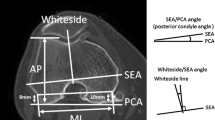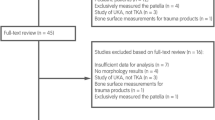Abstract
Purpose
Mismatch between partial imported prostheses and Chinese anatomy affects the clinical outcome of the procedure. The purpose of this study was to measure the anatomical dimensions of Chinese distal femurs to provide guidance for the design of more compatible distal femoral prostheses.
Methods
A total of 406 healthy distal femurs were reconstructed and measured. Consistency of these measurements and differences in sides, gender, and populations were examined. Parameter correlations were analyzed, and pairs with strong correlations underwent linear regression analysis. The design of distal femoral prostheses was referenced from the results of K-means and hierarchical clustering analysis.
Results
Ten parameters were measured, including the trans-epicondylar axis, width of the distal femur (ML), anteroposterior diameter of the distal femur (AP), etc. The intra-class correlation coefficient ranged from 0.795 to 0.999 for intra-observer consistency, and from 0.796 to 0.998 for inter-observer consistency. Males exhibited significantly larger parameters than females, except for the posterior condylar angle (all P values < 0.05). Compared to other populations, substantial differences were observed for most parameters, such as ML, AP, width of lateral femoral condyle, etc. (all P values < 0.05). Clustering analysis suggested that distal femoral prostheses should include at least five sizes to adequately accommodate the sampled population. ML sizes for males were 68, 70, 83, 73, and 89 mm, and for females 64, 65, 71, 67, and 77 mm. AP sizes for males were 56, 60, 60, 64, and 64 mm, and for females 48, 52, 54, 57, and 58 mm.
Conclusions
Chinese distal femur morphology, as analyzed using 3D techniques, varies significantly between genders and when compared with international data. For improved patient fit, the creation of five or more distal femur prostheses, diversified by gender and size and informed by the associated morphological parameters, is recommended.
Level of evidence
IV.





Similar content being viewed by others
Data availability
The data that supports the findings of this study are available on reasonable request from the corresponding author.
Abbreviations
- 2D:
-
Two-dimensional
- 3D:
-
Three-dimensional
- AP:
-
Anteroposterior diameter of the distal femur
- CI:
-
Confidence interval
- CT:
-
Computed tomography
- ICC:
-
Intraclass correlation coefficient
- LAP:
-
Anteroposterior diameter of the lateral femoral condyle
- LCW:
-
Width of lateral femoral condyle
- LPCH:
-
Height of the posterior part of the lateral femoral condyle
- MAP:
-
Anteroposterior diameter of the medial femoral condyle
- MCW:
-
Width of medial femoral condyle
- ML:
-
Width of the distal femur
- MPCH:
-
Height of the posterior part of the medial femoral condyle
- PCA:
-
Posterior condylar angle
- TEA:
-
Transepicondylar axis
References
Ames CP, Smith JS, Pellise F, Kelly M, Alanay A, Acaroglu E et al (2019) Artificial intelligence based hierarchical clustering of patient types and intervention categories in adult spinal deformity surgery: towards a new classification scheme that predicts quality and value. Spine (Phila Pa 1976) 44:915–926
Beckers L, Muller JH, Daxhelet J, Saffarini M, Ait-Si-Selmi T, Bonnin MP (2022) Sexual dimorphism and racial diversity render bone-implant mismatch inevitable after off-the-shelf total knee arthroplasty: a systematic review and meta-analysis. Knee Surg Sports Traumatol Arthrosc 30:809–821
Beeler S, Jud L, von Atzigen M, Sutter R, Furnstahl P, Fucentese SF et al (2020) Three-dimensional meniscus allograft sizing-a study of 280 healthy menisci. J Orthop Surg Res 15:74
Bernard-de Villeneuve F, Bizzozero P, Fabre-Aubrespy M, Ollivier M, Argenson JN (2023) Does matching femoral size and shape improve bone fit and patient-reported outcomes in TKA? A matched controlled study. Clin Orthop Relat Res 481:1129–1139
Birjandinejad A, Zandi R, Karimi E (2020) Anthropometric measurements of distal femur to design the femoral component of total knee arthroplasty for the iranian population. Arch Bone Jt Surg 8:400–406
Budhiparama NC, Lumban-Gaol I, Ifran NN, de Groot PCJ, Utomo DN, Nelissen R (2021) Mismatched knee implants in Indonesian and Dutch patients: a need for increasing the size. Knee Surg Sports Traumatol Arthrosc 29:358–369
Cikes M, Sanchez-Martinez S, Claggett B, Duchateau N, Piella G, Butakoff C et al (2019) Machine learning-based phenogrouping in heart failure to identify responders to cardiac resynchronization therapy. Eur J Heart Fail 21:74–85
Fong TS, Kim SC, Kim JE, Lee ES, Kim TW, Lee YS (2019) Morphometric assessment of resected femoral cut surface in Korean knees and its fitting with western-designed femoral components. J Arthroplasty 34:1929–1937
Gousopoulos L, Dobbelaere A, Ratano S, Bondoux L, ReSurg TCO et al (2023) Custom total knee arthroplasty combined with personalised alignment grants 94% patient satisfaction at minimum follow-up of 2 years. Knee Surg Sports Traumatol Arthrosc 31:1276–1283
Hamilton DF, Beard DJ, Barker KL, Macfarlane GJ, Tuck CE, Stoddart A et al (2020) Targeting rehabilitation to improve outcomes after total knee arthroplasty in patients at risk of poor outcomes: randomised controlled trial. BMJ 371:35–43
Hess S, Moser LB, Robertson EL, Behrend H, Amsler F, Iordache E et al (2022) Osteoarthritic and non-osteoarthritic patients show comparable coronal knee joint line orientations in a cross-sectional study based on 3D reconstructed CT images. Knee Surg Sports Traumatol Arthrosc 30:407–418
Hinterwimmer F, Lazic I, Suren C, Hirschmann MT, Pohlig F, Rueckert D et al (2022) Machine learning in knee arthroplasty: specific data are key-a systematic review. Knee Surg Sports Traumatol Arthrosc 30:376–388
Kornilov N, Lindberg MF, Gay C, Saraev A, Kuliaba T, Rosseland LA et al (2018) Higher physical activity and lower pain levels before surgery predict non-improvement of knee pain 1 year after TKA. Knee Surg Sports Traumatol Arthrosc 26:1698–1708
Kouz K, Brockmann L, Timmermann LM, Bergholz A, Flick M, Maheshwari K et al (2023) Endotypes of intraoperative hypotension during major abdominal surgery: a retrospective machine learning analysis of an observational cohort study. Br J Anaesth 130:253–261
Li K, Cavaignac E, Xu W, Cheng Q, Telmon N, Huang W (2018) Morphometric evaluation of the knee in Chinese population reveals sexual dimorphism and age-related differences. Int Orthop 42:2349–2356
Lin Y, Chen X, Li L, Li Z, Zhang Y, Fan P (2020) Comparison of patient satisfaction between medial pivot prostheses and posterior-stabilized prostheses in total knee arthroplasty. Orthop Surg 12:836–842
Loures FB, de Araujo Goes RF, de Sousa EB, Cavanellas N, Barretto JM, Tamaoki MJS et al (2020) Intraoperative morphometric study of distal femur in Brazilian patients undergoing total knee arthroplasty. PLoS ONE 15:2337–2349
Ma QL, Lipman JD, Cheng CK, Wang XN, Zhang YY, You B (2017) A comparison between chinese and caucasian 3-dimensional bony morphometry in presimulated and postsimulated osteotomy for total knee arthroplasty. J Arthroplasty 32:2878–2886
McNamara CA, Hanano AA, Villa JM, Huaman GM, Patel PD, Suarez JC (2018) Anthropometric measurements of knee joints in the hispanic population. J Arthroplasty 33:2640–2646
Saffarini M, Hirschmann MT, Bonnin M (2023) Personalisation and customisation in total knee arthroplasty: the paradox of custom knee implants. Knee Surg Sports Traumatol Arthrosc 31:1193–1195
Shao H, Chen C, Scholl D, Faizan A, Chen AF (2018) Tibial shaft anatomy differs between Caucasians and East Asian individuals. Knee Surg Sports Traumatol Arthrosc 26:2758–2765
Ten Hove D, Jorgensen TD, van der Ark LA (2022) Updated guidelines on selecting an intraclass correlation coefficient for interrater reliability, with applications to incomplete observational designs. Psychol Methods 2022:516–554
Wang B, Zhang G, Pu R, Li Q, Wang Y (2023) Clinical significance of distal femur morphology in a healthy Mongolian youth population. Sci Rep 13:81–87
Wang L, Tian DM, Liu X, Zhang JF, Zhao LM, He X et al (2019) Morphological measurement of supracondylar femur based on digital technology in Chinese Han population. Orthop Surg 11:294–303
Acknowledgements
We are very grateful for the software and technical consultation provided by the E3D digital medical team of Central South University, led by Prof. Shenghui Liao. We thank each of the anonymous patients included in this study.
Funding
No funding was received for this work.
Author information
Authors and Affiliations
Contributions
SC: Substantial contributions to the research design, model construction, data acquisition, statistical analysis, drafting the paper and revising it critically; ZZ: Model construction, data acquisition, approval of the submitted and final version; JG: Manuscript revision, approval of the submitted and final version; SH: Manuscript revision, approval of the submitted and final version; WZ: Manuscript revision, approval of the submitted and final version; JX: Supervising the proper application of research, manuscript revision, approval of the submitted and final version; WW: contributions to the research design, manuscript revision, approval of the submitted and final version.
Corresponding authors
Ethics declarations
Conflict of interest
The authors declare they have no conflict of interest.
Ethical approval
The study was reviewed and approved by the institutional review board of Quzhou Affiliated Hospital of Wenzhou Medical University.
Informed consent
Informed consent was waived due to the nature of the retrospective study and the fact that all data were de-identified.
Additional information
Publisher's Note
Springer Nature remains neutral with regard to jurisdictional claims in published maps and institutional affiliations.
Supplementary Information
Below is the link to the electronic supplementary material.
Rights and permissions
Springer Nature or its licensor (e.g. a society or other partner) holds exclusive rights to this article under a publishing agreement with the author(s) or other rightsholder(s); author self-archiving of the accepted manuscript version of this article is solely governed by the terms of such publishing agreement and applicable law.
About this article
Cite this article
Chen, S., Zheng, Z., Guo, J. et al. Five or more gender- and size-diverse customizations of distal femur prostheses are needed to improve fit for Chinese knees. Knee Surg Sports Traumatol Arthrosc 31, 5388–5397 (2023). https://doi.org/10.1007/s00167-023-07580-z
Received:
Accepted:
Published:
Issue Date:
DOI: https://doi.org/10.1007/s00167-023-07580-z




